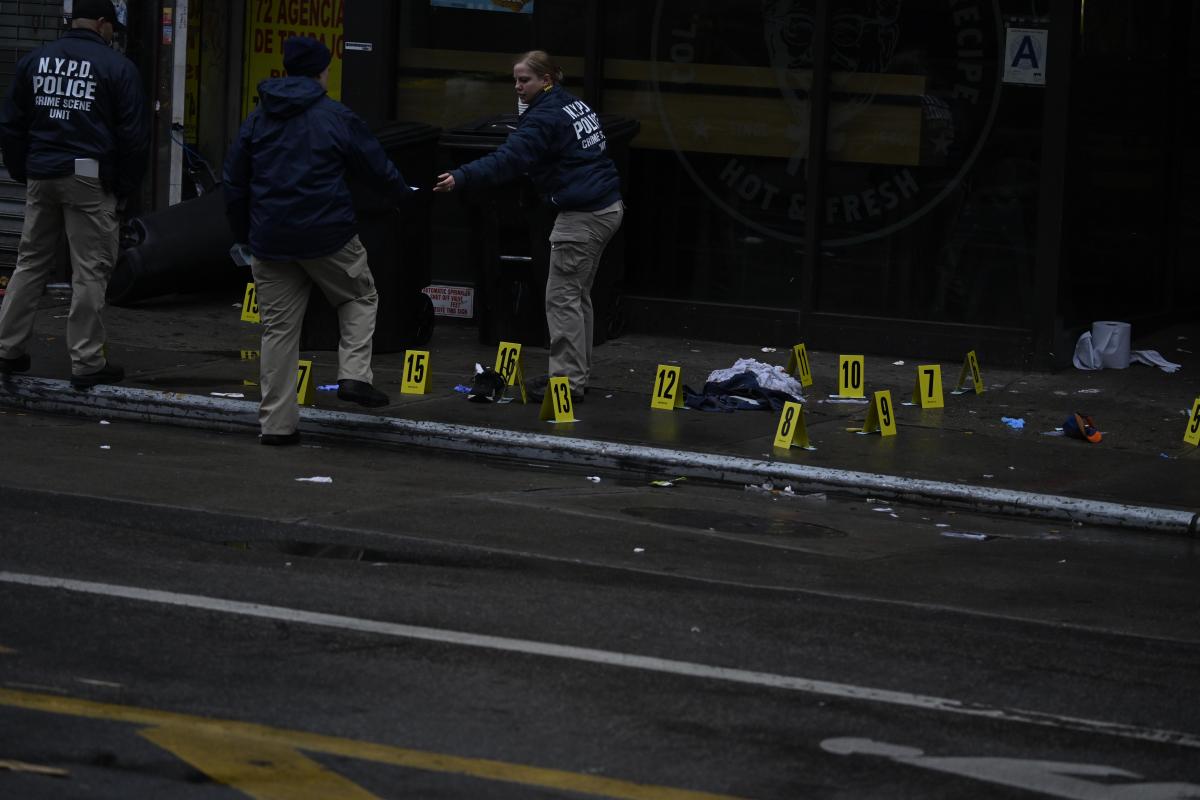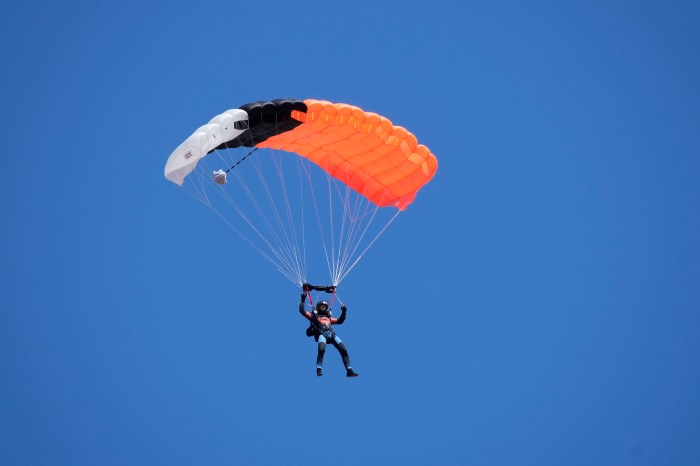By Arlene McKanic
The art deco Queens Theater in the Park at the foot of the skeletons of the abandoned “flying saucer” buildings in Flushing Meadows Corona Park is now the setting of an intriguing exhibit, “Real Life Pictures.”
The photos, taken by three artists, deal with the crummy and quotidian, but in ways that make you look at them anew — this, after all, is the function of art. The exhibit is curated by Robyn Love, the QTP gallery curator.
In Patricia Zarate’s “Foreign and Domestic” (2001) we see the outside of a shuttered auto-parts place for foreign and domestic cars. The foreground is muddy, and a rusted hull of an SUV with its front ripped out has been reconfigured into something useful — a garden umbrella has been stuck in its front. On top of the building we see what look like little weird sculptures that are probably auto parts, and the sky above it is the most cheerful bright blue possible. The sky’s just as blue in her other photos.
“Body Shop” (2001) shows what seems to be the same place as “Foreign and Domestic,” though a graffiti artist has painted the words Body Shop over the corrugated iron. In “DeCar Auto” (2001) — I know if this is a deliberate misspelling, because it’s Dacar auto in the photo — an otherwise run-down building is painted bright white, yellow and green, and embellished with colorful graffiti.
In “Red and Black” (2001), two wrecked cars, one black and one bright red, have been hoisted above a dilapidated iron wall. A series of photos called “If You’re Thinking of Living In …” (taken from the New York Times real estate series) are shots of crooked, crumbly, yard-less, broken-house facades. You wouldn’t think of living in any of these houses unless you had to, but even they possess a sort of diseased beauty. The artist’s books, “Iron Triangle” and “Another Book,” placed under glass nearby, feature more photos of unglamorous places.
The next set of photos is by Eva Melas, who travels around New York City and photographs people and things. A sculptor as well as a photographer, she is interested in the shapes of things, and how they take up space (“I always carry my camera — if I see something that stands out, I take the shot,” she told Qguide). In “Comfort” (1997), an Easter basket is filled with a stuffed bunny and candy, all wrapped in cellophane. “City” (1996) is a portrait of knick-knacks, prayer cards, bottles, masks, flasks shaped like human tongues and other stuff you may or may not want to touch. At the bottom of this pile what looks like a puddle of blood seems to ooze out of one of the masks. “Addiction” (1997) is a display-case full of chocolate shaped like the Eiffel tower, lips, champagne bottles and other things. The scene is dominated by a torso draped with a rhinestone necklace and a bow — I wasn’t sure if it was edible. Next is “Swill” (1997), which shows a window full of Vodka bottles of all shapes and sizes, dominated by a Carmen Miranda -like head. In “Lace” (1999), a doll stands draped near bolts of more beautiful fabric fit for wedding or bridesmaids’ gowns or wild costumes.
In the “Coffee Cup Series” (2000) Melas has photographed abandoned coffee cups — you’ve seen them — on a pipe next to a fire hydrant, on the top of pay phone and among other junk. In “Home” (2001), a man and a woman share a large mattress covered with a child’s blanket. They don’t seem to be lovers, since they’re turned away from each other, but rather two homeless folks who have simply agreed, for the time being, to share a mattress on a junk-filled corner.
The “Interesting Lady” (1997) stands a bit forlornly in a fabric shop, with a violently red feather boa around her neck. The “Interesting Ladies and Men Series” (1996-2001) include a woman in a huge blue wig and psychedelic mini dress, an exotically dressed girl carrying a puppy in a brat pack like a baby, a schoolgirl in a tight-fitting blue shirt, light skirt and heavy boots — she’s not quite a geek because she’s too pretty and seems too self-confident — and an older lady in an ill-fitting blue satin gown.
The last photo, “Interesting Man” (1996) is of a man in red and white checked pants, a tie made in the likeness of a trout, a loud Hawaiian shirt, a blazer full of pastel colors, and a purple ribbon — he’s a judge of something or other. Oh yes, he wears a hat adorned with guinea fowl feathers as well. He’s not the least bit self-conscious and the viewer wonders what matter of contest he could have been judging.
The exhibit continues downstairs with Jessica Watson’s photographs. Using a point-and-shoot camera, Watson specializes in extreme closeups of body parts, and of every day stuff seen from a quirky perspective.
In “Untitled (Two Girls)” (2001), we see the girls’ arms and hands; in “Untitled (Cat and Candlestick)” (2000), the cat’s almost accidental head is juxtaposed with the drippy, ugly candlestick. In other photos we see a crease in a couch, a knee, a roundish white lamp embraced by flowers, a hand messily slicing a mango and a glimpse of a hairy leg, a knee peeking provocatively from a slit in a dress, the roundness of two arms. On other walls we have
“Untitled (Yellow Glove)” (2001): A woman removes a boot from someone with her gloved hands — the one glove we see, the brightest spot in the picture, is yellow. In “Untitled (Sink)” (2001) a green dishtowel is draped over the divide in a dirty porcelain sink. In “Untitled (Pig)” (2001) a pig pigs out on apple slices, and in “Untitled (Knees)” (2001) knees loom like mountains.
In “Untitled (Goats)” (2001) the thing one notices about the cloven-hooved beasties who have buried their snouts in a bucket of foot is the extreme length and floppiness of their ears. In “Untitled (Spoons)” (2001), two utensils gently, glowingly touch each other on a landscape of clean brown fabric. The last photo, “Untitled (Stockings)” (2001), is funny; a woman’s feet are trapped in twisty nylon. Any woman will recognize it as that frustrating moment when the stockings have been put over the toes but have yet to be pulled, with no little struggle, the rest of the way up the legs and over the hips.
“Real Life” is at the Queens Theater in the Park through Dec. 10, and it’s free. Call (718) 760-0686 for more information.
Reach Qguide writer Arlene McKanic by e-mail at Timesledger@aol.com or call 229-0300, Ext. 139.






























